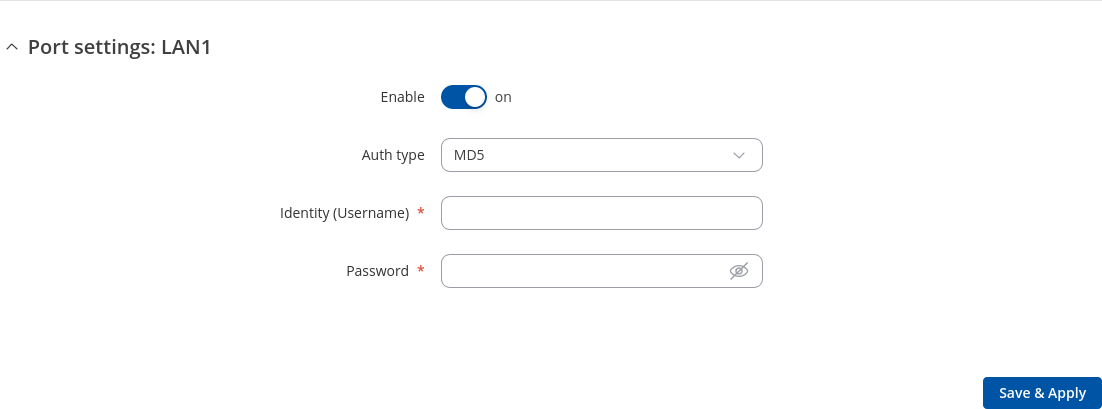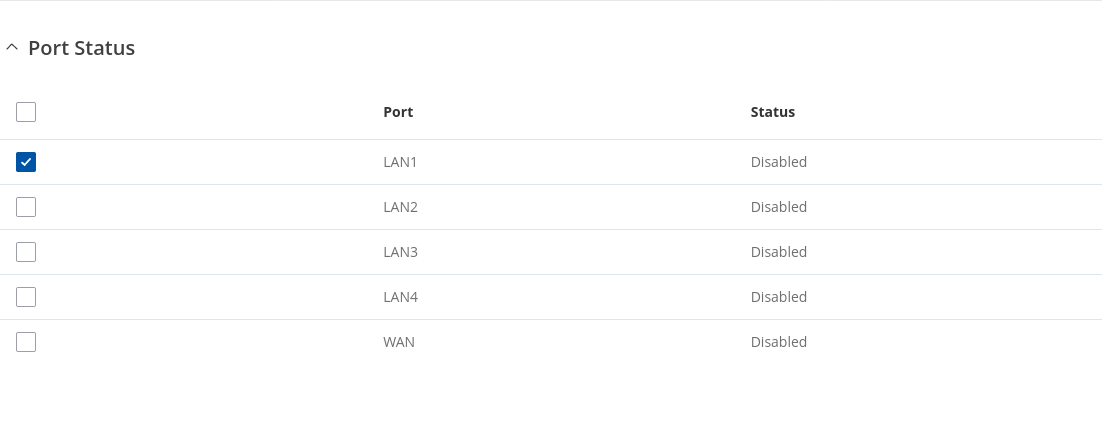RUTM50 Ports
The information in this page is updated in accordance with firmware version RUTM_R_00.07.08.
Summary
The Ports page provides information related to the status of the device's physical ports, as well as the ability to edit port settings.
If you're having trouble finding this page or some of the parameters described here on your device's WebUI, you should turn on "Advanced WebUI" mode. You can do that by clicking the "Advanced" button, located at the top of the WebUI.
Port Settings
This section displays information about the status of the device's ports with the ability to configure port settings.
All Ports
The figure below is an example of the All Ports window, color indicates port speed and status:
To change port settings select port and press `edit (number of ports) ports` button:
You will be redirected to `Port settings`. From here you can enable/disable ports or change settings.
| Field | Value | Description |
|---|---|---|
| Enable | off | on; default: on | Toggle port on or off. |
| Auto negotiation | off | on; default: on | Auto negotiation allows the device to communicate with devices on the other end of the link to determine the optimal duplex mode and speed for the port. |
| Link Speed | 10Mbps (E) | 100Mbps (FE); default: 10Mbps (E) | A measure of how fast ports are able to transmit and receive data. |
| Duplex | Full | Half; default: Full | Bidirectional communication system that allows both end nodes to send and receive communication data or signals. Full - sends and receives simultaneously. Half - sends or receives one path at a time. |
| Advertisement | 10M-Half | 10M-Full | 100M-Half | 100M-Full; default: Auto | Advertises preferred duplex mode and speed for negotiation with other devices. |
Port Status
This section displays port status information. There is also an option to select ports:
Port Mirroring
Port Mirroring (may also be referred to as SPAN (Switched Port Analyzer)) is a service that relays a copy of all network packets - incoming and outgoing on one Ethernet port (Source Port) to another (Monitoring Port).
| Field | Value | Description |
|---|---|---|
| Monitoring port | Disabled | LAN1 | LAN2 | LAN3 | LAN4; default: Disabled | The port which will mirror the packets. |
| Source port | Disabled | LAN1 | LAN2 | LAN3 | LAN4; default: none | Port whose packets will be mirrored. |
| Enable mirroring of incoming packets | off | on; default: off | |
| Enable mirroring of outgoing packets | off | on; default: off |
802.1X Client
802.1X is a network authentication protocol that opens ports for network access when an organization authenticates a user's identity and authorizes them for access to the network. The user's identity is determined based on their credentials or certificate, which is confirmed by the authentication server.
All Ports
The figure below is an example of the All Ports window, color indicates port speed and status:
To change port settings select port and press `edit (number of ports) ports` button:
You will be redirected to `Port settings`. From here you can change 802.1X settings.
| Field | Value | Description |
|---|---|---|
| Enable | off | on; default: off | Toggle 802.1x on or off. |
| Auth type | MD5 | TLS | PWD | Tunneled TLS | Protected EAP (PEAP); default: MD5 | Authentication type. |
| Identity (Username) | string; default: none | Used as the username for authentication. |
| MD5, PWD, Tunneled TLS, Protected EAP (PEAP): Password | string; default: none | Used for authentication. |
| TLS: CA Certificate | .crt file; default: none | Radius server CA certificate. |
| TLS: User certificate | .crt file; default: none | TLS client certificate. |
| TLS: Private Key | .key file; default: none | TLS Private Key. |
| TLS: Private Key Password | string; default: none | TLS Private Key Password. |
| Tunneled TLS: Inner authentication | PAP | MSCHAP | MSCHAPv2 | MSCHAPv2 (no EAP) | CHAP | MD5 | GTC; default: PAP | Inner authentication type. |
| Protected EAP (PEAP): Inner authentication | MSCHAPv2 | MD5 | GTC; default: MSCHAPv2 | Inner authentication type. |
| Protected EAP (PEAP): Peap version | auto | 0 | 1; default: auto | Peap version. |
| Tunneled TLS, Protected EAP (PEAP): Anonymous identity | string; default: none | Shown as username outside the encrypted tunnel. Not used for authentication. |
| Tunneled TLS, Protected EAP (PEAP): CA Certificate | .crt file; default: none | Radius server CA certificate. |
Port Status
This section displays port status information. There is also an option to select ports:







